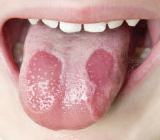When you visit your dentist, they are not only examining your teeth but your entire mouth, including your tongue. This month with Hartwell Dentistry we will discussing why we check your tongue and what exactly your tongue is telling us.
WHAT IS YOUR TONGUE TELLING YOU?
The tongue takes up most of the space in our mouths and is important for speaking, swallowing and tasting food. It is exposed to the same foods and drinks that our teeth and gums are, but are you taking care of your tongue? There are many tongue conditions and appearances that can show us signs about the rest of your general health.
What should a healthy tongue look like?
A healthy tongue should generally appear pale pink and fairly uniform in colour. It should be fairly smooth with no cracks, indentations and uniform in size from right side to left with no coatings on the surface.
http://sfglobe.com/2016/03/07/what-your-tongue-is-telling-you-about-your-body/
Some common tongue conditions
A condition that occurs when there is an increased growth of the tissue on the tongue which makes it look “hairy”. The main causes include poor oral hygiene, certain mouthwashes, stress, and thrush. Sometimes the ‘hair-like’ projections can become black/brown in colour, this can be a result of mainly smoking and diet, staining the tongue tissues to become darker in colour. To treat/prevent this, good oral hygiene including brushing or scraping the tongue can be done.
http://www.ghorayeb.com/TongueBlackHairy.html
Anaemic Glossitis
If the tongue appears a pale pink colour that is smooth and shiny this could be related to an Iron Deficiency. Along with appearance changes, you may also get a burning sensation and taste loss. A visit to your GP may be needed for deficiency testing.
Geographic tongue
Geographic tongue is a presentation with in a small amount of the general population. The tongue will have darker pink areas that can appear smooth with white borders and can change position over time. It is called geographic tongue as the patches can somewhat resemble a geographic map.
Although it can look concerning, geographic tongue is harmless, most people don’t realise it’s there, or you may occasionally get a burning sensation. You may notice that the patches may change and move over time or even disappear for a while. The exact reason for this occurring is unknown.
http://www.mountainbrooksmiles.com/blog/post/what-in-the-world-is-geographic-tongue.html
Candidiasis.
Candida(thrush) is a common fungal infection which can appear on many surfaces on the mouth including the tongue. It can appear as a white coating on the tongue, which can be scraped off to reveal a red patch underneath. This can be caused by poor oral hygiene, dry mouth, dentures, being on broad spectrum antibiotics. This can be treated with anti-fungal medication.
EFFECT on the body overall if untreated can cause sinus congestions leading to headaches, fatigue, weakness, muscle pain
Vitamin B complex deficiencies.
Depending on which vitamin B is deficient in the diet the tongue can appear in different ways. Generally it is hard to be deficient in one vitamin B on its own, there is usually a few that are lacking in the diet.
When there is a Vitamin B deficiency the tongue can enlarge and appear dark to bright red and even purple in colour, often with a smooth/glossy appearance from loss of taste buds on parts of the tongue. Please see your GP to check for dietary deficiencies if your tongue appears like this.
Cracked/fissured
If the tongue appears cracked it could be a sign of vitamin deficiencies. It has also been said that people that have skin conditions such as psoriasis have an increased chance of having a cracked/fissured tongue. Some people that have a consistently dry mouth (xerostomia) can have some minor cracks on the tongue. To care for a cracked tongue, good oral hygiene is essential to ensure debris does not get lodged in the cracks, rinsing after meals may help with this.
Scalloped tongue
A scalloped tongue appears with a wavy like shape at the edges of the tongue, this could be just at the side or all the way around the tongue. This is caused by the indentation of the teeth on the tongue, often because the tongue is quite large compared to the size of the mouth, so the tongue becomes jammed up close to the teeth causing the indentations. This could be a sign of thyroid issues or more commonly a sign of sleep apnoea. One of the main reasons for sleep apnoea is the size of the tongue is large enough to obstruct breathing at night time. Sleep apnoea can be a big health issue, if you notice your tongue has scalloped edges, book an appointment with Hartwell Dentistry to get yourself assessed for sleep apnoea.
http://medmum.com/wp-content/uploads/2015/11/scalloped-tongue-picture-295×210.png
Non-Symmetrical shape
Our tongue should be uniform in shape and size. Sometimes swelling can occur due to trauma, if we have bitten or burnt our tongue or had an allergic reaction. Generally our mouth heals very quickly, our tongue is very vascular so any minor cuts and sores tend to heal fast (within days). If you notice a sore on the tongue or any lumps and bumps that lasts more than 2 weeks, it is important to get it checked out by a dentist to assess the issue.
How to look after our tongue
As with our teeth, the tongue can catch plaque on the surface. Often we can get a coating of plaque on the tongue which needs to be removed. After we brush our teeth it is a good idea to give the tongue a brush to remove any plaque forming which can cause bad breath. A tongue scraper can also be used to clean the tongue, which come in a range of different shapes and sizes.
*** Tip: when cleaning your tongue, focus on breathing through your nose.





